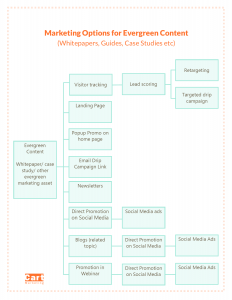I’m a fan of case studies. It might be because I actually enjoy writing them, but it’s also because I think they are a great platform to do so many things. But sharpen your pencils folks, because a good case study isn’t an easy thing to write.
Crowd Research Partners and the LinkedIn group Technology Marketing completed a survey in 2016 of 600 B2B marketers and found that 55% reported case studies as their most effective type of content. I’m not surprised. There are many benefits to a good case study. They do however take a good bit of work so be prepared to dedicate some resources to it. To make that easier, you can download our free Case Study Planner – which isn’t a template to actually write the case study, it’s a series of questions to help you pull together the facts and details that will make up your case study.
So why do I love case studies. Here is my list of the biggest benefits for B2B marketing.
(Fair warning. This blog contains more buzzwords than it should. Sorry about that)
1. They’re engaging
Case studies can be engaging if they tell a story. In today’s content marketing world, telling an authentic, one of a kind story is what everyone is trying to achieve. If your company has any sort of a content marketing strategy, you will know that writing the next blog, and the next blog, and the next blog becomes a difficult task. It isn’t the actual writing of the blog that’s the hard part, deciding what to write the blog about is.
If you write a case study that is authentic and one-of-a-kind, the reader will finds bits and pieces they can relate too. In other words, they can put themselves into the story you are telling. That’s a hard thing to achieve with just another blog.
Keep in mind however, that it’s not you that is telling the story. It’s your client. Put the case study together from their perspective. Talk more about them and their goals, challenges, and achievements, then about the features and benefits of your products and services. Your client’s story makes for more interesting and engaging content than a bullet list of all the great things you did for them.
2. Case studies offer social proof
Most of us fall victim to social proof every day. Your first exposure was likely the classic McDonald’s sign that told us how many billions of people they’d served. As a kid, that always amazed me and I wanted to know what number I was.
Today, there is a name and buzzword for what McDonald’s did for so long. It’s called social proof and it can range widely from app ratings in the Google Play store to celebrity endorsements. However, for the vast majority of SMBs in the B2B world, social proof comes by way of testimonials and case studies.
Social proof is someone else saying how great you are, which carries a lot more weight than if it’s just you telling everyone how great you are.
A case study is putting your relationship with a client in full view for others to understand how much you have done for them. Even though it’s you who’s putting the case study out there, if it comes from the client’s point of view, it’s their story and their endorsement.
Ideally, the client you choose as the basis for your case study is someone who represents your target audience, and is a respected brand in their industry. You want others to recognize the client, understand what that client has in common with them, and have them see this as a peer-to-peer message. The case study essentially helps you position a client as a champion of your brand and the good work you do.
3. They become evergreen content
Evergreen content is essential to every content marketing strategy. It’s the c ontent you create that seems to last forever and you can use over and over again in a bunch of ways. Typically, evergreen content are things like how-to’s, industry guides, FAQs, whitepapers, and of course case studies.
ontent you create that seems to last forever and you can use over and over again in a bunch of ways. Typically, evergreen content are things like how-to’s, industry guides, FAQs, whitepapers, and of course case studies.
When evergreen content is done well, it remains relevant for a long time. That doesn’t mean it never gets updated, but it does mean that several years from now, someone new can discover your evergreen content and find it just as helpful as the person who discovers it right after you create it.
You’ll often see companies counting on their evergreen content to help them rank well in search engine results. Great content can do that for you because others like to link to timeless information; but hopefully, you are pointing people to it too. This is a graphic I share with some of my clients to help them understand why investing in whitepapers, case studies, and other evergreen content is worth their consideration. Once you have the piece developed, you can use it in a variety of ways, directing people to it through email, other content like blogs, in webinars or newsletters, etc. You can even gate the case study (ask for contact information for the free download) as a way to capture the names of leads and begin to track them.
4. Your competitors can’t say the same thing
It’s hard to stand out in the crowd sometimes. For many companies, the content they develop, whether it be their website content, brochures, blogs, guides, or whitepapers, looks very similar to that of their competitors. This is especially true if you work in an industry where what you have to say is very similar to what everyone you’re competing with has to say.
A case study is different. It’s something your competition can’t write because it’s your client and your experience with them that you’re sharing.
Because your case study is unique, it’s interesting, refreshing, and lets your audience experience something new. This also makes it more memorable and more likely to gain the attention of your audience beyond just a quick few scrolls of their mouse.
5. Make it a benefit for your customer
Much like asking for referrals or testimonials, not everyone is comfortable asking a client to agree to be the subject of a case study. Making the case study a medium for your client to also deliver their message makes it a win-win for both of you.
In your case study, position your client’s experience around why it was a priority to engage services or products like yours. For example, if you are an IT managed services provider, talk about how important data security is for your client and how it was the driving force behind why they migrated from an on-site server that made them vulnerable, to a cloud option.
You’re client gets to demonstrate how smart they are for making strategic decisions important to how they do business, and you get to look like the hero who came in and helped them do that. Win-win.
The key here is to talk about the client’s goals, what they’re good at, why they were smart enough to make the decision to do what they did, and how much better they are now that they did it. Then, show them how and where you’re going to share it, and give it to them to do the same thing.
A few tips to help you along the way
- Case studies can come in lots of different formats: written documents, videos, webinars with you and the client, Q & As, or podcasts. Be creative.
- Keep track of them and update them when they need to be updated so nothing seems dated down the road.
- Optimize them for keywords just like you would with any other piece of content you develop.
- Use graphics to summarize or explain things, and use images of the real people – not stock photos.
- Find the right clients as the subject. Here are the hints you’ll find in our Case Study Planner:
- Have been a long-term client
- Is a satisfied customers with no issues or concerns expressed
- Has a good relationship with their sales or support team member
- Represents the industry or client profile you’re targeting with the case study
- Include quotes that you can later use as testimonials in other places.
- Don’t make it too long or nobody will read it all and format it professionally so people want to see it.
Ready to get started on a case study for your business? Download our free Case Study Planner or contact us if you wan’t some help.



